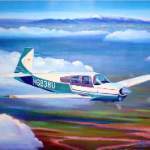-
Posts
336 -
Joined
-
Last visited
Geoff's Achievements
-
Hi Don,
We met at the Cheyenne PPP, I am one of the new instructors. I have a client who has a Bravo and I wanted to ask if you wouldn't mind sharing your speeds and checklist document or any other document where your discuss the key number concept '53'. I would like to use it to help my client with proper engine management.
Regards,
Geoff Reid.
-

Hi Geoff,
I've attached my speeds and checklist document. The key number 53 for the Bravo is confirmed from the red Lycoming manual. I fly at 75% power: 29" MP, 2400 RPM. I lean to keep my TIT at 1600°F or lower. At that power setting the FF should be between 17.5 and 18 gal/hour ROP. I don't fly Lycomings LOP.
Don
-
Thanks Don. Hope to see you in Branson.
-








